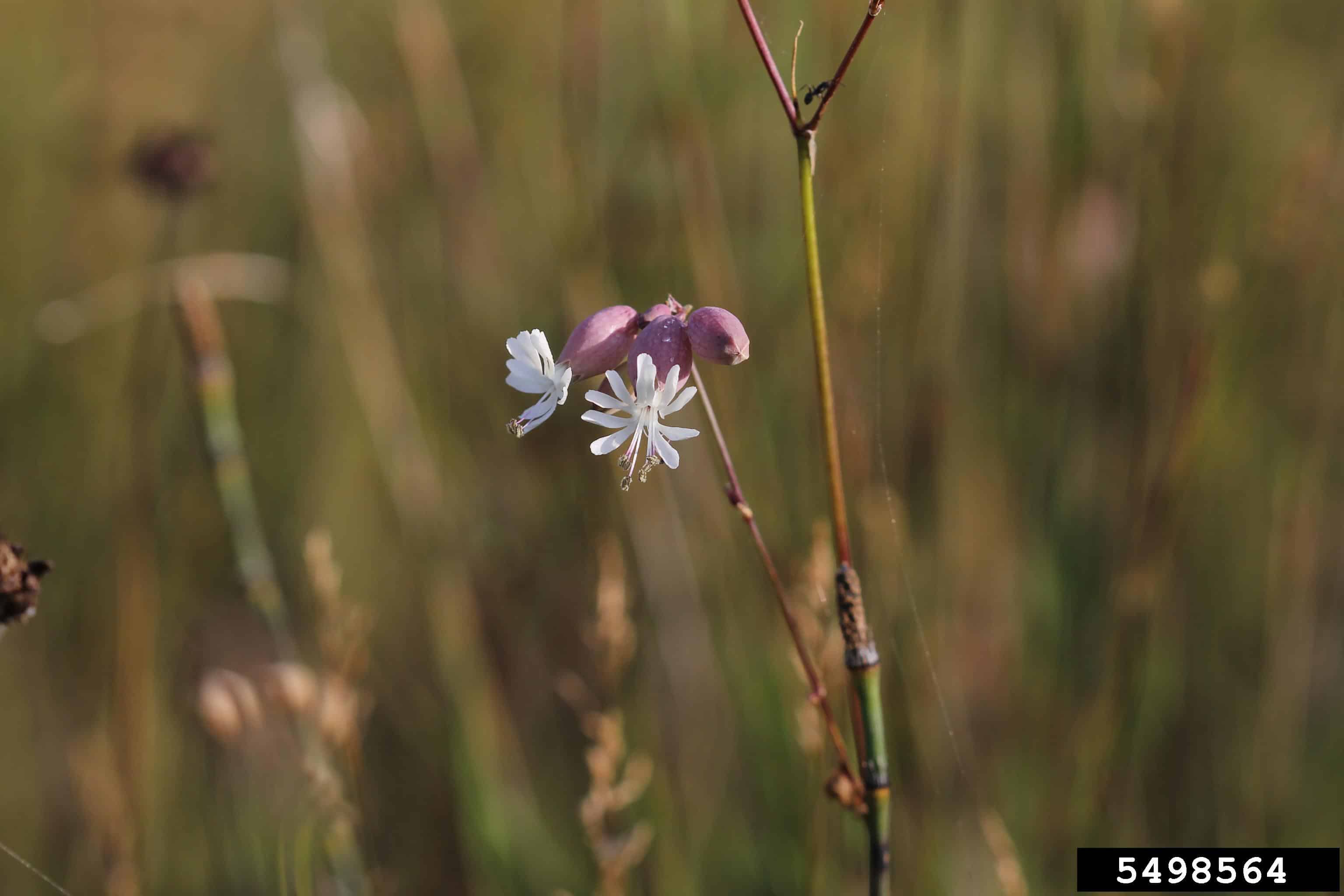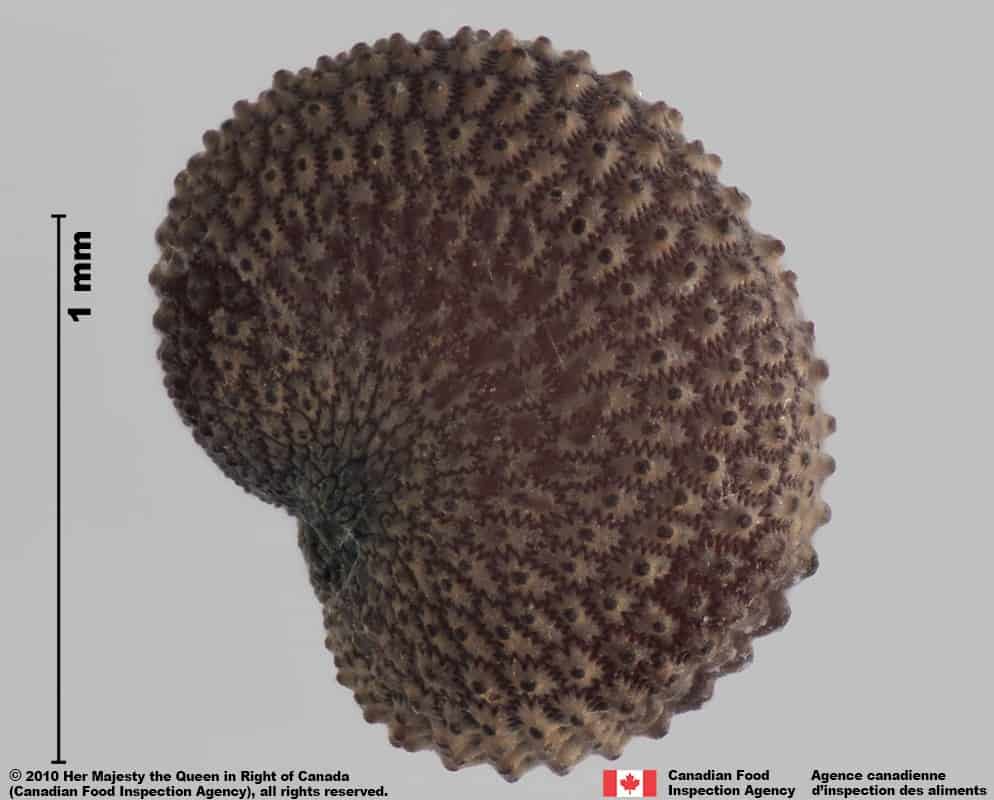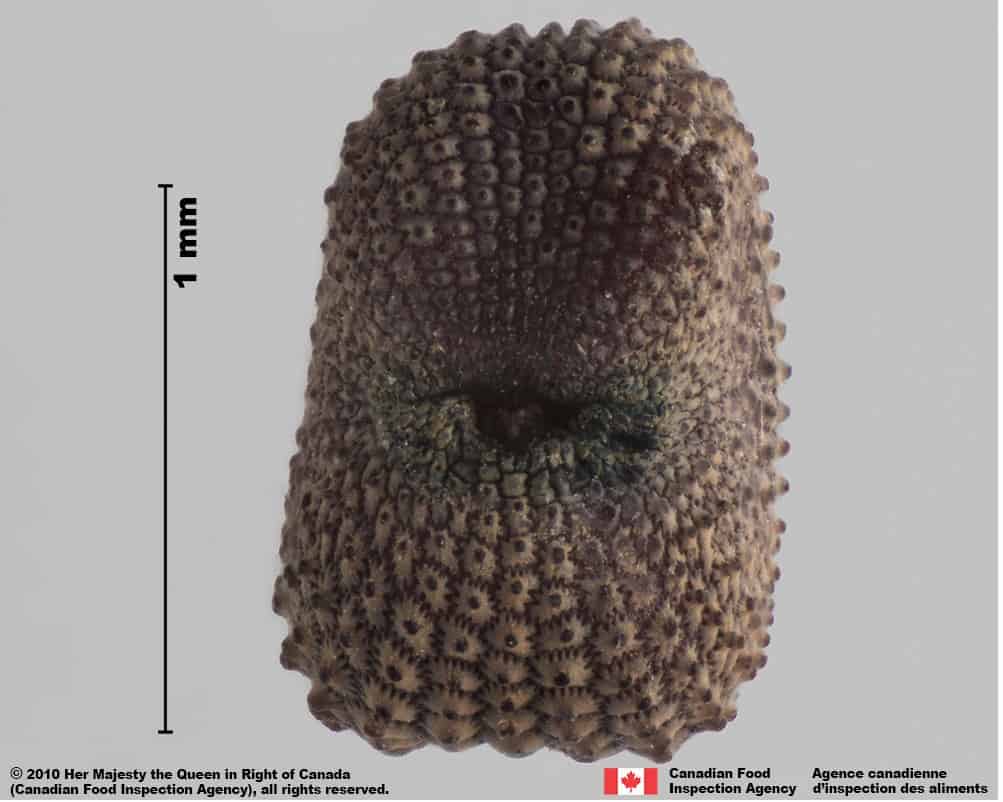Silene vulgaris
Overview
Aperçu
Regulation :
Remarques Réglementation:
- CFIA Weed Seeds Order - Class 3: Secondary Noxious Weed Seeds
Regulation Notes:
Distribution :
Répartition :
Native to northern Africa, Europe and temperate Asia and introduced in North America and South America, South Africa, Japan, Australia and New Zealand (USDA-ARS 2021). In the United States, found in most states except for some in the south (USDA-NRCS 2021). Occurs throughout Canada except in the Northwest Territories and Nunavut (Brouillet et al. 2010+); is common in the eastern provinces (Darbyshire 2003).
Habitat and Crop Association :
Habitat et Cultures Associées :
Cultivated fields, old fields, pastures, hay fields, gardens, shores, gravel pits, roadsides, disturbed areas (FNA 1993+; Royer and Dickinson 1999; Darbyshire 2003). Not a serious weed in cultivated fields but can become weedy in zero to minimum-till fields (Royer and Dickinson 1999).
Economic Use, cultivation area, and Weed Association :
Utilisation économique, zone de culture et association de mauvaises herbes :
Duration of Life Cycle :
Durée du cycle vital:
Perennial
Dispersal Unit Type :
Type d’unité de dispersion :
Seed
General Information
RENSEIGNEMENTS GÉNÉRAUX
Introduction of Silene vulgaris into North America appears to have occurred in the late 18th or early 19th century via ship ballast or contaminated Trifolium species (clover) seed (Taylor and Keller 2007).
.
Silene vulgaris flowers (Rob Routledge, Sault College, Bugwood.org)
Identification
Identification
-
Capsule
Size
- Capsule length: 12.0 – 18.0 mm; width: 7.0 – 11.0 mm (FNA 1993+)
Shape
- Capsule is oval or globose shaped (FNA 1993+)
Surface Texture
- Surface is smooth
Colour
- Capsule is shiny straw yellow coloured
Other Features
- Capsule is shiny green when immature
- Capsule disperses the seeds through opening by six tooth-like valves (FNA 1993+)
-
Seed
Size
- Seed length: 1.1 – 1.9mm; width: 0.8 – 1.6 mm
*Note: minimum and maximum of 10 seeds in a normal range of this species using image measurement (ISMA 2020)
Shape
- Seed D-shaped, heart-shaped, or wedge-shaped, compressed in edge view
Surface Texture
- Surface is stellate grooved reticulate with papillate tubercles in the interspaces
- The tubercles arranged into rows
Colour
- The seed is dark red coloured with a thin coating that obscures the surface colour as dull grey, yellow or brown
- Immature seeds are red or reddish-brown coloured
Other Features
Hilum & Hilum area
- The hilum is in the middle of the straight edge of the seed
- Hilum flanked on each side by two long, raised pads that curve towards the hilum
- The pads have a grooved reticulate texture with rectangular interspaces

Bladder campion (Silene vulgaris) seeds






-
Embryo
Size
- Embryo partially fills the seed
Shape
- Embryo is curved, in a peripheral position
Endosperm
- Endosperm is translucent white coloured
Identification Tips
CONSEILS POUR L’IDENTIFICATION
There are 700 species of Silene worldwide, and 70 occur in North America (FNA 1993+). The seeds of these species are generally D-shaped with stellate grooved reticulation and papillate tubercles. Five species with large seeds are commonly encountered as field weeds in temperate climates: S. dichotoma, S. dioica, S.latifolia, S. noctiflora and S. vulgaris. Seed features that distinguish these species include: shape, tubercle arrangement, colour and raised areas around the hilum.
S. dichotoma seed is generally wedge-shaped, compressed in edge view, long reticulation interspaces, yellowish or reddish colour with two curved pads flanking the hilum. S. dioica seeds are D-shaped, inflated in edge view, with pointed papillate tubercles in small interspaces. The surface is reddish coloured and the hilum is surrounded by a raised collar.
Seeds of S. latifolia are D-shaped, inflated in edge view, small reticulation interspaces, yellow or white coloured, with a raised collar around the hilum. S. noctiflora seed is D-shaped, compressed in edge view, long reticulation interspaces, reddish or yellow coloured with two small pads flanking the hilum. S. vulgaris seeds can be D- or wedge-shaped, compressed in edge view, with tubercles arranged in rows. The reticulation interspaces are a mix of square and rectangular shapes, grey, yellow or brownish coloured with two large pads flanking the hilum.

Bladder campion (Silene vulgaris) seed






Additional Botany Information
AUTRES RENSEIGNEMENTS BOTANIQUES

Silene vulgaris flower (David Cappaert, Bugwood.org)



Similar Species
ESPÈCES SEMBLABLES
Similar species are based on a study of seed morphology of various species, and those with similar dispersal units are identified. The study is limited by physical specimen and literature availability at the time of examination, and possibly impacted by the subjectivity of the authors based on their knowledge and experience. Providing similar species information for seed identification is to make users aware of similarities that could possibly result in misidentification.
Silene noctiflora L. (night-flowering catchfly)
S. noctiflora seeds are generally smaller (length*: 0.9 – 1.3 mm; width: 0.8 – 1.1 mm), D-shaped, with tubercles that may or may not be in rows, hilum with two small pads and dull yellow coloured. S. vulgaris seed can be wedge-shaped, tubercles in rows, hilum with two large pads and generally dull grey coloured.
Silene latifolia Poir. (white cockle)
S. latifolia seed is generally smaller (length*: 1.0 – 1.6; width: 0.9 – 1.3 mm), D-shaped, inflated in edge view, tubercles not in rows, dull yellow or white coloured, with a collar around the hilum. S. vulgaris seed can be wedge-shaped, compressed in edge view, tubercles in rows, hilum with two large pads and generally dull grey coloured.
*Note: minimum and maximum of 10 seeds in a normal range of this species using image measurement (ISMA 2020)
Click to select species
Cliquez pour sélectionner les espèces

Silene noctiflora

Silene latifolia
Comparison Window
Fenêtre de comparaison
MAIN SPECIES
ESPÈCES PRINCIPALES
Silene vulgaris

Silene vulgaris
Caryophyllaceae
Bladder campion (Silene vulgaris) seeds
MAIN SPECIES
ESPÈCES PRINCIPALES
Silene vulgaris

Silene vulgaris
Caryophyllaceae
Bladder campion (Silene vulgaris) seeds
MAIN SPECIES
ESPÈCES PRINCIPALES
Silene vulgaris

Silene vulgaris
Caryophyllaceae
Bladder campion (Silene vulgaris) seed, hilum view
MAIN SPECIES
ESPÈCES PRINCIPALES
Silene vulgaris

Silene vulgaris
Caryophyllaceae
Bladder campion (Silene vulgaris) seed
MAIN SPECIES
ESPÈCES PRINCIPALES
Silene vulgaris

Silene vulgaris
Caryophyllaceae
Bladder campion (Silene vulgaris) seed, profile
MAIN SPECIES
ESPÈCES PRINCIPALES
Silene vulgaris

Silene vulgaris
Caryophyllaceae
Bladder campion (Silene vulgaris subsp. vulgaris) seed, hilum (close-up view)
SIMILAR SPECIES
ESPÈCES SEMBLABLES
Silene noctiflora

Silene noctiflora
Caryophyllaceae
Night-flowering catchfly (Silene noctiflora) seeds
SIMILAR SPECIES
ESPÈCES SEMBLABLES
Silene noctiflora

Silene noctiflora
Caryophyllaceae
Night-flowering catchfly (Silene noctiflora) seeds
SIMILAR SPECIES
ESPÈCES SEMBLABLES
Silene noctiflora

Silene noctiflora
Caryophyllaceae
Night-flowering catchfly (Silene noctiflora) seed
SIMILAR SPECIES
ESPÈCES SEMBLABLES
Silene noctiflora

Silene noctiflora
Caryophyllaceae
Night-flowering catchfly (Silene noctiflora) seed, side view
SIMILAR SPECIES
ESPÈCES SEMBLABLES
Silene noctiflora

Silene noctiflora
Caryophyllaceae
Night-flowering catchfly (Silene noctiflora) seed, hilum view
SIMILAR SPECIES
ESPÈCES SEMBLABLES
Silene noctiflora

Silene noctiflora
Caryophyllaceae
Night-flowering catchfly (Silene noctiflora) seed, hilum (close-up view)
Need ID Help?
Besoin d’aide pour l’identification?
Reference(s)
Référence(s)
Brouillet, L., Coursol, F., Meades, S. J., Favreau, M., Anions, M., Bélisle, P. and Desmet, P. 2010+. VASCAN, the database of vascular plants of Canada. http://data.canadensys.net/vascan/ Accessed August 12, 2021.
Darbyshire, S. J. 2003. Inventory of Canadian Agricultural Weeds. Agriculture and Agri-Food Canada, Research Branch. Ottawa, ON.
Flora of North America (FNA) Editorial Committee, eds. 1993+. Flora of North America North of Mexico [Online]. 22+ vols. New York and Oxford. Accessed December 29, 2022.
Global Biodiversity Information Facility (GBIF) Secretariat. 2022. https://doi.org/10.15468/39omei Accessed via https://www.gbif.org/species/9172281 Accessed December 29, 2022.
Government of Canada (GC). 2016. Canadian Weed Seeds Order. https://laws-lois.justice.gc.ca/eng/regulations/SOR-2016-93/page-2.html (English) https://laws-lois.justice.gc.ca/fra/reglements/DORS-2016-93/page-2.html (French)
Integrated Taxonomic Information System (ITIS). 2021. https://www.itis.gov/ Accessed August 12, 2021.
International Seed Morphology Association (ISMA). 2020. Method for Seed Size Measurement. Version 1.0. ISMA Publication Guide.
Royer, F. and Dickinson, R. 1999. Weeds of Canada and the Northern United States. The University of Alberta Press/Lone Pine Publishing, Edmonton, Alberta.
Taylor, D. R. and Keller, S. R. 2007. Historical Range Expansion Determines the Phylogenetic Diversity Introduced During Contemporary Species Invasion. Evolution: Volume 61 (2): 334-345.
U.S. Department of Agriculture-Agricultural Research Services (USDA-ARS). 2021. Germplasm Resources Information Network (GRIN), https://npgsweb.ars-grin.gov/gringlobal/taxon/taxonomysimple.aspx Accessed August 12, 2021.
U.S. Department of Agriculture-Natural Resources Conservation Service (USDA-NRCS). 2021. The PLANTS Database. National Plant Data Team, Greensboro, NC USA. http://plants.usda.gov Accessed August 12, 2021.




